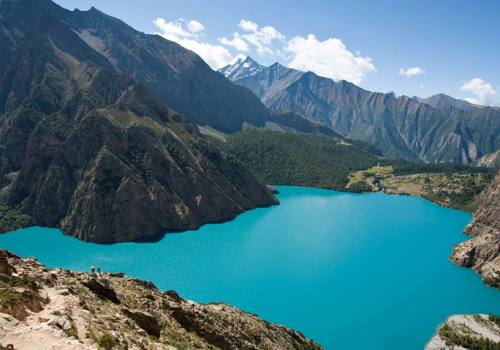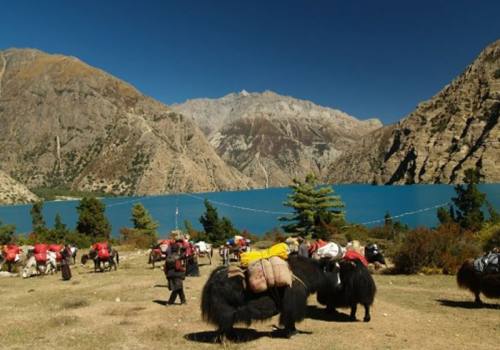Dolpo Region
Dolpo is a culturally Tibetan region in western NepalValleys (south), and the Phoksumdo and Mugu Karnali Valleys (west and northwest). To the southwest lies Dhaulagiri, the sixth highest mountain in the world (8172 meters). This massif and its outliers create a rainshadow that determines much of Dolpo’s climate. Though no meteorological records have been kept in Dolpo, its valleys probably receive less than five hundred millimeters of precipitation yearly.
Dolpo is home to some of the highest villages on earth; almost ninety percent of the region lies above 3,500 meters. The population of Dolpo is less than five thousand people, making it one of the least densely populated areas of Nepal. Its inhabitants wrest survival from this inhospitable landscape by synergizing agriculture, animal husbandry, and trade. Dolpo’s agro-pastoral livelihood is characterized by migrations between permanent villages and pastures at higher altitudes. More than ninety percent of the population lives under the poverty line, literacy is low, and life expectancy is a mere fifty years. Administratively, the valleys of Dolpo are located in the northern reaches of Nepal’s largest district, Dolpa. This region is also referred to as ‘Upper’ Dolpo by His Majesty’s Government of Nepal, a designation which has restricted foreigners from traveling extensively in this area.
Historically, the Dolpo region was located in the kingdom of Zhangzhung. Located in western Tibet, this kingdom was strongly connected with the Bön religion. The first Tibetan dynasty (Yarlung) conquered much of the territory that encompasses the Tibetan-speaking world, including Zhangzhung, between the sixth and eighth centuries. Populations migrated from Zhangzhung to areas east and south, including Dolpo; the name for this region first appears in written sources at this time.
The dominion of the western Tibetan dynasties over Dolpo was eclipsed during the fourteenth century by the principality of Lo (in present-day Mustang District, Nepal). Thereafter, Dolpo villagers paid tributes to the Kingdom of Lo in the form of grains, labor, and religious service. One manner in which Dolpo’s villagers paid their annual taxes was by painting thangka and carving mani walls. Tenzin Norbu counts among his ancestors painters who traveled to Manthang, the capital of Lo, to participate in the creation of the renowned paintings at Thubchen and Jampa monasteries.
Dolpo was for centuries a relatively independent region in constant economic and cultural interaction with the greater, rivaling political powers that surrounded it. Dolpo was always too rugged, sparsely populated, and distant from the major passes over the Himalaya to become a major political entity: it was instead a pawn in the power struggles of competing kingdoms like Lo and Jumla, which sought control of trade routes across the Himalaya. Pastoralists and farmers living in the trans-Himalayan region were drawn into networks of exchange, cycles that often followed the calendar of religious festivals.
Nepal, the nation-state that eventually incorporated Dolpo, began taking shape in the mid-1700s when the Gorkha tribes and their leader, Prithvi Narayan Shah, consolidated power, conquered neighbors, and worked their way toward Kathmandu, which they seized in 1769. By 1789, the Gorkhas had extended their territorial control over the economically powerful Kali Gandaki valley and subsumed theKingdom of Lo. Dolpo thus became the Gorkhas’ when Lo relinquished political power over the Kali Gandaki and surrounding regions.
Tremendous displacements have marked the experience of Dolpo’s communities over the past fifty years: the assertion of Chinese authority over Tibet (and subsequent restrictions on the traffic of people, animals, and goods across its borders); the expansion of communications and transportation infrastructure in Nepal (which opened these remote villages to new goods and people, altering economics and crossing cultures); and the rise of modern nation-states like the People’s Republic of China and Nepal (with their attendant visions of development for their peripheral populations).
After the 1960s, Dolpo was no longer as isolated or self-governing as it once was: its autonomy was bounded when the Chinese closed the borders of Tibet. Across the Tibet phenomenon. External forces, including the creation of Nepal’s largest national park, Shey Phoksundo, and the making of the major motion picture, Himalaya, have introduced new elements of social and economic change to the people of Dolpo.
Package (s)
Dolpo & Phoksundo Lake
A magnificent short trek into the heart…
Dolpo Highlights
Rediscover the lost Shangri-La of Dolpo
Company Profile











